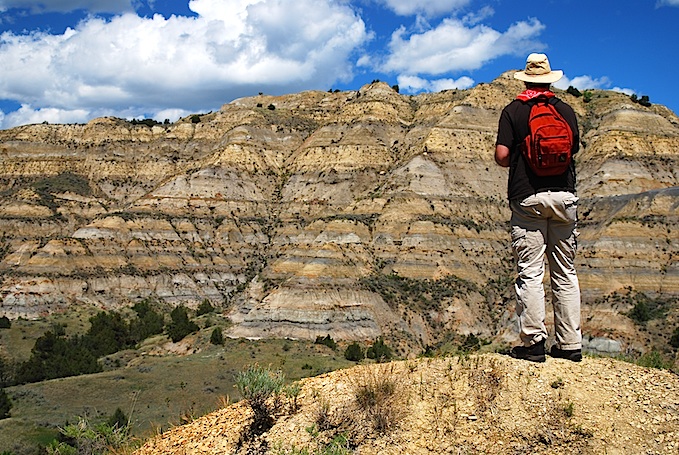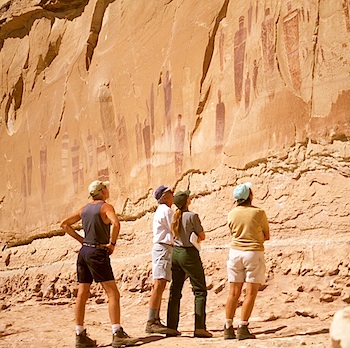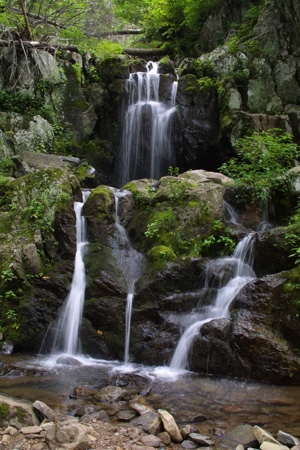Yes, our national parks are grappling with the loss of millions of dollars due to the failure of Congress and the Obama administration to treat the country's ailing fiscal condition.
But they're still open, and they remain spectacular places to explore.
I say that having recently visited Canyonlands and Capitol Reef national parks, where rangers were available for leading hikes into the past, campgrounds were full of laughing children darting about on bikes, and budget cuts were carefully tucked out of sight.
Indeed, around the National Park System parks seem to be making do.

The sequestration hasn't dimmed the magnificence of Theodore Roosevelt National Park. Kurt Repanshek photo.
At Yellowstone National Park in Wyoming, the budget situation pulled communities together to help the park crews clear the interior roads of snow in time for the normal spring opening. Farther north at Glacier National Park in Montana, the Glacier National Park Conservancy contributed $10,000 to the efforts to plow the 50-mile Going-to-the-Sun Road so it can open on schedule as well.
At Acadia National Park in Maine, the spring opening is being pushed back a month to save money and avoid impacting the bulk of the vacation season later this summer. Along the Natchez Trace Parkway that rolls from Nashville, Tennessee, to Natchez, Mississippi, officials are juggling as best they can hours of visitor centers and comfort stations, along with grass cutting operations, to maintain a semblance of normalcy this summer. In short, park managers are trying to make do.
No doubt, as the high season begins to swing into gear we'll notice things when we visit the parks. Not as many ranger-led programs. Locked doors and shorter hours at some visitor centers. Closed campgrounds that make the ones remaining open more of a challenge to land a site in. Some tours at Mammoth Cave National Park won't be conducted this summer, campfire programs at other parks are being canceled, there will be no rangers to interpret the Cape Lookout Lighthouse at that national seashore.
But, by and large, the simple fact is that the parks are not closed, the views remain spectacular, and the access is largely up to you. That, actually, is pretty much the model the Park Service long has operated under -- come to the parks, enjoy yourself, and appreciate these natural, historic, and cultural treasures.
Since boyhood in New Jersey to my current grounding in Utah, I’ve had wonderful opportunities to explore the parks quite literally from A -- Acadia -- to Z -- Zion -- and never come away disappointed.
Even if there are fewer ranger-led programs this summer, you won’t want for enjoyment.
When my wife and I hit the road on Easter weekend to visit the Horseshoe Canyon unit of Canyonlands National Park in Utah, we happened upon a ranger ready to lead a tour into the canyon to view the Great Gallery rock art. This magnificent open air gallery, created thousands of years ago by Archaic nomads, rises solemnly above the wash. Painted, as well as chiseled, into the sandstone cliff, the images are mysterious as well as baffling. What thought spawned the Holy Ghost? How did the artists manage to create an 8-foot-tall figure so high on the sandstone wall? What messages were travelers supposed to take away from these images?
We had planned to do the hike ourselves, but we couldn't pass up a chance to share the experience with the ranger. It turned into a private tour, as no one else showed up. She added to the richness of our hike with a geology primer, details on the efforts decades ago to find oil that led to the trail down into Horseshoe Canyon, and in discussing both the rock art and the ecology within the canyon.

The Great Gallery is incredible, with or without a ranger. Kurt Repanshek photo.
While these ranger-led hikes to the Great Gallery have been reduced from both Saturdays and Sundays to just Saturdays, and will end May 25, the canyon won't be locked, you'll still be able to hike down yourself and stand in awe before the rock art that has endured for thousands of years.
From Horseshoe Canyon we headed down the road to Capitol Reef, which was doing a booming business that weekend. The campgrounds were full, the visitor center busy with folks looking for guidebooks and souvenirs, and the parking lot nearing capacity at times as visitors stopped to pick up some guides, fill their water bottles, get directions to the nearest trail, or check out the pictographs on the sandstone cliffs across Utah 24 from the visitor center.
We can gripe and complain about how the politicians in Washington are managing our fiscal affairs. But we can't say we're shut out of the parks or that there's nothing to do or see in them since the ranks of rangers have been trimmed by some 1,000 seasonal positions and 900 permanent ones.
Both the Skyline Drive through Shenandoah National Park and the Blue Ridge Parkway that roams farther south down to Great Smoky Mountains National Park remain open to motorists, as do their surrounding landscapes for hiking, birding, and picnicking. The surf continues to pound the cobbled shores of Acadia, Cape Cod National Seashore's beaches will still be available for cooling off this summer, as will those at Fire Island National Seashore and the other national seashores and lakeshores in the park system.
You still can stand alongside the towering sequoias in Kings Canyon and Sequoia national parks in California, explore the tide pools of Olympic National Park in Washington state, and vanish into the mountains of North Cascades National Park, also in the Evergreen state.

The waterfalls are still falling at Shenandoah National Park. NPS photo by John Mitchell.
Going forward, what will be interesting to see is whether this turns into a long-term scenario, and if so, how will park managers cope, and how will visitors react? What will the on-the-ground impact be?
Can the national parks somehow absorb these cuts and welcome the public with reduced services long-term? And how will the public react? Will they read stories of diminished ranger ranks, fewer interpretive programs, and harder to find campsites, and stay away?
Or will they turn out regardless to enjoy these pleasuring grounds, to take advantage of programs offered by national park friends groups and cooperating associations, and to even pause to lend a hand with collecting litter or maintaining a trail?
These are our national parks, and they’re waiting for us.



Comments
"...it's not self interest, its conflicting visions."
Perhaps some of each. In terms of self-interest, two examples come immediately to mind: (1) Consider how many important decisions are postponed in Congress (and by the White House) until after an upcoming election, because politicians simply don't want to have to take a position on a multitude of issues too close to election day. One of our problems is the length of time for such inaction seems to get longer and longer. (2) The gerrymandering of voting districts to protect the power of the party in control of the legislature in a state.
Point number one helps explain in part how we found ourselves in the situation that was the original subject of this story: "sequestration."
The reason congress acted so fast on the air traffic controllers was that it was affecting them from getting home each week.Self serving people.
Life is simple it's us humans that mess it up.
??????????????
What is conflicting about either power or wealth? Are you "conflicted" because you have neither?
In some people, power and great wealth can become visions or obsessions that conflict with honesty, humility, integrity, compassion, and a genuine interest in the goodness and welfare of their neighbors. Some of us realize that we can have -- or at least try to have -- all those virtues and that they can be far more valuable than all the gold or percieved power available anywhere.
Maybe it's some of those old fashioned values that drive many people to volunteer as members of search and rescue organizations, or volunteer to work with poverty stricken children or the mentally ill, or who take their medical skills to undeveloped parts of the world -- or even parts of our own nation. Or those who choose jobs that don't pay much in dollars but provide an incredibly valuable feeling of satisfaction for the soul -- such as teachers, firefighters, or even park rangers. Those are the kind of people of whom we need more in the world. And, I would suggest, among our political leaders.
I believe you are correct, Lee. A great humbling that these places provide, if the effort is made, would be invaluable. Have often thought I'd like to lead political leaders on serious backcountry and river adventures because I've seen how transformational these trips are to folks. Like your post, Lee.
What does wealth have to do about anything in life.If wealth was all that great why do the wealthy have so may problems in life just like us poor folk.
I'm fine just the way I'am,other than I wish I had better health but nobody can make a call on that one rich or poor.
And no I didn't smoke,over drink,eat junk food.
Life is about setting personal goals and working toward them.Too many people are worried about the next guy.
TnHiker I agree with you when you state:
"We can do just fine with 5%-10% less refinement and maintenance in our national parks. Perhaps our park managers will learn to focus on essential items and curtail some of the "foo-foo" details that really don't further our ability to enjoy the natural beauty of our parks."
Enjoying the national parks (or state parks or state forests) doesn't depend on fancy programming IMHO. To me, its the serenity of nature we go there to experience. And Mother Nature maintains herself quite nicely.
Lee, I am inclined to agree. A truly excellent book on the subject is "To Big to Fail" by Andrew Sorkin. Mr. Sorkin was a Wall Street Journal investigative reporter, just an excellent read on the melt down of 2008. Also Lee, thank you for the heads up on "The Soul of Yosemite" by Barbara Moritsch, also Rick Smiths book review. Barbara's book is excellent and is a must read for those that are interested in the last 15 years of litigation history in Yosemite National Park. .